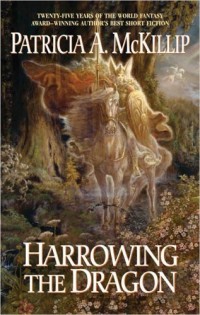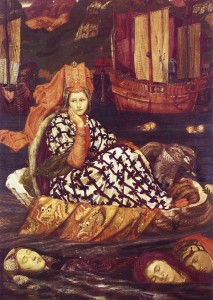 In fantasy circles, Patricia A. McKillip has long been considered a consummate stylist, and her style has been the main reason I have read thirteen of her novels (with several more to read on my shelf). I was particularly interested in reading McKillip’s Harrowing the Dragon (Ace, 2005; all quotations are taken from this edition), which is her only short-story collection. Her poetic style is well suited to the length of a short novel, pulling readers not only into her imaginary worlds but immersing them in her language. McKillip’s particular style draws on syntax and diction primarily to create its poetry, and these two in turn beget the dreamy, languorous feel that pervades her work, whether novel or short story. Warning: Spoilers to follow.
In fantasy circles, Patricia A. McKillip has long been considered a consummate stylist, and her style has been the main reason I have read thirteen of her novels (with several more to read on my shelf). I was particularly interested in reading McKillip’s Harrowing the Dragon (Ace, 2005; all quotations are taken from this edition), which is her only short-story collection. Her poetic style is well suited to the length of a short novel, pulling readers not only into her imaginary worlds but immersing them in her language. McKillip’s particular style draws on syntax and diction primarily to create its poetry, and these two in turn beget the dreamy, languorous feel that pervades her work, whether novel or short story. Warning: Spoilers to follow.
To begin, I wondered if McKillip’s style would be as effective in the shorter form—would her style would feel more heavy in a shorter piece?—but reading Harrowing the Dragon with a careful eye demonstrated that the relatively short length of her stories does not distract from the stylistic impact. The fifteen stories in Harrowing average about twenty-one pages in length; seven of the stories are twenty pages or more in length, five are ten to twenty pages, and only three are less than ten pages. But in each story, regardless of length, McKillip’s style manages to sweep the reader into the brief world and hold him there, much in the same way her style works in a novel.
Most of the stories—actually, all but two—are secondary world fantasy, and some are interrelated, sharing geography although not characters. One might argue that McKillip’s poetic style is well matched for the secondary world fantasy, which can be as lush and romantic as possible without, perhaps, straining the reader’s credulity. Let’s examine the first paragraph of the first story of the collection, “The Harrowing of the Dragon of Hoarsbreath”:
Once, on the top of a world, there existed the ring of an island named Hoarsbreath, made out of gold and snow. It was all mountain, a grim, briny, yellowing ice-world covered with winter twelve months out of thirteen. For one month, when the twin suns crossed each other at the world’s cap, the snow melted from the peak of Hoarsbreath. The hardy trees shrugged the snow off their boughs and sucked in light and mellow air, pulling themselves toward the suns. Snow and icicles melted off the roofs of the miners’ village; the snow-tunnels they had dug from house to tavern to storage barn to mine shaft sagged to the ground; the dead white river flowing down from the mountain to the sea turned blue and began to moved again. Then the miners gathered the gold they had dug by firelight out of the chill, harsh darkness of the deep mountain and took it downriver, across the sea to the mainland, to trade for food and furs, tools and a liquid fire called wormspoor because it was gold and bitter, like the leavings of dragons. After three swallows of it, in a busy city with a harbor frozen only part of the year, with people who wore rich furs, kept horses and sleds to ride in during winter, and who knew the patterns of the winter stars since they weren’t buried alive by the snow, the miners swore they would never return to Hoarsbreath. But the gold waiting in the dark secret places of the mountain-island drew at them in their dreaming, lured them back. (1-2)
McKillip begins the passage with “Once, on the top of a world,” evoking both fairy tales and something stranger because it is “the top of a world” rather than “the top of the world.” Most of the paragraph is taken up with the description of “summer” on Hoarsbreath, but the sensation given to the reader is one of cold by use of particular words: “snow” is repeated in some form or another five times; other cold words include “winter” (three times), “ice,” “icicles,” “dead white,” “chill,” and “frozen.” This sensation of cold is coupled with a sense of weight: the island is an “ice-world covered with winter,” and the miners build “snow-tunnels” and recognize that the mainlanders are freer because they “weren’t buried alive by the snow,” even though the miners return to Hoarsbreath. Another stylistic device McKillip uses is compound descriptions, either through sequencing or pairing. With sequencing, McKillip goes for lists of descriptors: “a grim, briny, yellowing ice-world”; “from house to tavern to storage barn to mine shaft”; “the chill, harsh darkness”; “the dark secret places of the mountain-island.” She uses pairing to add layers as well: “light and mellow air”; “food and furs, tools and a liquid fire”; “gold and bitter.” The effect of both the sequencing and the pairing is in the rhythm and cadence of the sentences, creating a more lyrical sound. Note also McKillip’s use of alliteration and unexpected phrasing, which evokes poetry, as in this sentence: “But the gold waiting in the dark secret places of the mountain-island drew at them in their dreaming, lured them back.”
The stylistic devices discussed above—particularly compound descriptions and unexpected alliterative phrasing—recur throughout McKillip’s stories, calling forth a more heightened poetic quality. (It’s worth noting here that the sensory descriptors McKillip relies on most heavily are visual.) In “The Snow Queen,” based on Andersen’s fairy tale, McKillip uses these stylistic devices to create something otherworldly in a story set in our recognizable world. At a party, “Selene flung her fruity voice into the throng and hurried after it” (151). After Neva has stolen away Kay, during breakfast “Her face and white negligee, a lacy tumble of roses, would slide like light past his groping fingers…” (162) and she “leaned over his prone body, delicately sipped coffee. Then she opened her mouth against his ear and breathed a hot, moist sigh throughout his bones” (164). Later, at another party, “The world and winter returned; the inventions of the insubstantial stranger Foxx turned into dreams and air, and she laughed again, knowing that the potting soil would be there tomorrow and the ports would not” (172). Kay grows “so pale and weary” (173), and at the end Foxx is “mute and grumpy” (175).
McKillip’s style is never forced, nor does it overwhelm the reader (not every sentence employs those stylistic devices), but it does add a rhythmic, dream-like quality to her prose. Given that my own style tends to be a bit more poetic than most speculative fiction writers, I feel more confident finding my own voice after reading writers like McKillip.





